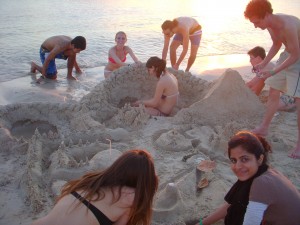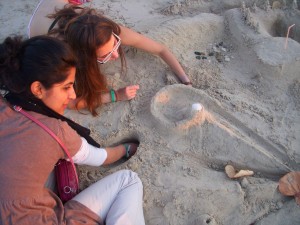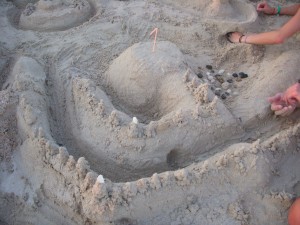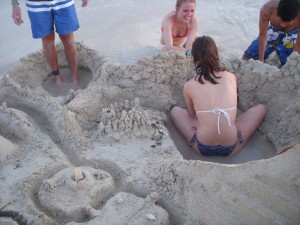UNESCO world heritage sandcastle
May 4, 2012 by ancarias
During our stay at Hotel Ancon in Trinidad, some of the class while lounging on the beach decided to build a sandcastle. A childhood activity that all of us are familiar with is usually a simple and childish activity but can become a complex and elaborate creation with a little effort. As highly intelligent college students the class took sandcastle building to a whole other level.
Thus the UNESCO world heritage sandcastle was built.

As our sandcastle grew the elements of the UNESCO site became more and more elaborate, including but not limited to;
Transportation, complete with tunnel and roads

Housing and a structured government

education in the form of a science institute and a long standing cathedral built during the establishment of the site.

Two quarries used for building, also from the establisment of the site (Alexis is sitting in the original quarry and Dylan’s feet are in the newer quarry)
The site also included a fortificated wall for protection and an art museum to show case the cultivation of the culture.
The sandcastle became less and less a simple sandcastle and more and more a manifestation of the things we had learned and seen about Cuba. In class we had studied UNESCO world heritage sites and while in Cuba had the privilege of visiting several of them and experience what UNESCO is trying to preserve.
But what exactly makes a site UNESCO world heritage site quality?
the criteria from the UNESCO website are as follows
- to represent a masterpiece of human creative genius;
- to exhibit an important interchange of human values, over a span of time or within a cultural area of the world, on developments in architecture or technology, monumental arts, town-planning or landscape design;
- to bear a unique or at least exceptional testimony to a cultural tradition or to a civilization which is living or which has disappeared;
- to be an outstanding example of a type of building, architectural or technological ensemble or landscape which illustrates (a) significant stage(s) in human history;
- to be an outstanding example of a traditional human settlement, land-use, or sea-use which is representative of a culture (or cultures), or human interaction with the environment especially when it has become vulnerable under the impact of irreversible change;
- to be directly or tangibly associated with events or living traditions, with ideas, or with beliefs, with artistic and literary works of outstanding universal significance.
- to contain superlative natural phenomena or areas of exceptional natural beauty and aesthetic importance;
- to be outstanding examples representing major stages of earth’s history, including the record of life, significant on-going geological processes in the development of landforms, or significant geomorphic or physiographic features;
- to be outstanding examples representing significant on-going ecological and biological processes in the evolution and development of terrestrial, fresh water, coastal and marine ecosystems and communities of plants and animals;
- to contain the most important and significant natural habitats for in-situ conservation of biological diversity, including those containing threatened species of outstanding universal value from the point of view of science or conservation.
Each of Cuba’s 9 UNESCO world heritage sites has been evaluated and found to fit these 10 criteria and when visiting Trinidad and Old Havana it was obvious why they were chosen and preserved by the organization. The architecture, culture, people, and history of the sites we visited were each in their own right culturally significant. I believe that us as a class took those significant aspects and internalized them and somehow they manifested themselves in the creation of our very own sandcastle civilization. A civilization that started with a simple idea and developed through many stages of enlightenment and cultivation and eventually became our own UNESCO site. I guess that’s what happens when Vassar students build sandcastles.
Leave a Reply
You must be logged in to post a comment.